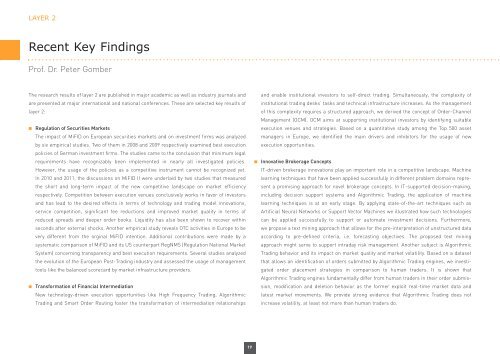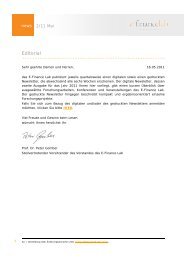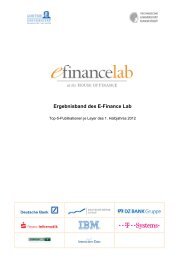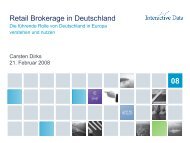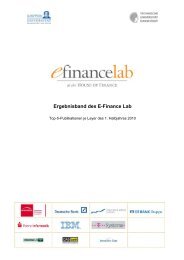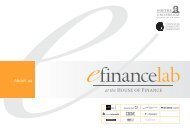The E-Finance Value Chain - E-Finance Lab Frankfurt am Main
The E-Finance Value Chain - E-Finance Lab Frankfurt am Main
The E-Finance Value Chain - E-Finance Lab Frankfurt am Main
Create successful ePaper yourself
Turn your PDF publications into a flip-book with our unique Google optimized e-Paper software.
LAYER 2<br />
Recent Key Findings<br />
Prof. Dr. Peter Gomber<br />
<strong>The</strong> research results of layer 2 are published in major academic as well as industry journals and<br />
are presented at major international and national conferences. <strong>The</strong>se are selected key results of<br />
layer 2:<br />
n Regulation of Securities Markets<br />
<strong>The</strong> impact of MiFID on European securities markets and on investment firms was analyzed<br />
by six empirical studies. Two of them in 2008 and 2009 respectively ex<strong>am</strong>ined best execution<br />
policies of German investment firms. <strong>The</strong> studies c<strong>am</strong>e to the conclusion that minimum legal<br />
requirements have recognizably been implemented in nearly all investigated policies.<br />
However, the usage of the policies as a competitive instrument cannot be recognized yet.<br />
In 2010 and 2011, the discussions on MiFID II were underlaid by two studies that measured<br />
the short and long-term impact of the new competitive landscape on market efficiency<br />
respectively. Competition between execution venues conclusively works in favor of investors<br />
and has lead to the desired effects in terms of technology and trading model innovations,<br />
service competition, significant fee reductions and improved market quality in terms of<br />
reduced spreads and deeper order books. Liquidity has also been shown to recover within<br />
seconds after external shocks. Another empirical study reveals OTC activities in Europe to be<br />
very different from the orginal MiFID intention. Additional contributions were made by a<br />
systematic comparison of MiFID and its US counterpart RegNMS (Regulation National Market<br />
System) concerning transparency and best execution requirements. Several studies analyzed<br />
the evolution of the European Post-Trading industry and assessed the usage of management<br />
tools like the balanced scorecard by market infrastructure providers.<br />
n Transformation of Financial Intermediation<br />
New technology-driven execution opportunities like High Frequency Trading, Algorithmic<br />
Trading and Smart Order Routing foster the transformation of intermediation relationships<br />
19<br />
and enable institutional investors to self-direct trading. Simultaneously, the complexity of<br />
institutional trading desks’ tasks and technical infrastructure increases. As the management<br />
of this complexity requires a structured approach, we derived the concept of Order-Channel<br />
Management (OCM). OCM aims at supporting institutional investors by identifying suitable<br />
execution venues and strategies. Based on a quantitative study <strong>am</strong>ong the Top 500 asset<br />
managers in Europe, we identified the main drivers and inhibitors for the usage of new<br />
execution opportunities.<br />
n Innovative Brokerage Concepts<br />
IT-driven brokerage innovations play an important role in a competitive landscape. Machine<br />
learning techniques that have been applied successfully in different problem domains represent<br />
a promising approach for novel brokerage concepts. In IT-supported decision-making,<br />
including decision support systems and Algorithmic Trading, the application of machine<br />
learning techniques is at an early stage. By applying state-of-the-art techniques such as<br />
Artificial Neural Networks or Support Vector Machines we illustrated how such technologies<br />
can be applied successfully to support or automate investment decisions. Furthermore,<br />
we propose a text mining approach that allows for the pre-interpretation of unstructured data<br />
according to pre-defined criteria, i.e. forecasting objectives. <strong>The</strong> proposed text mining<br />
approach might serve to support intraday risk management. Another subject is Algorithmic<br />
Trading behavior and its impact on market quality and market volatility. Based on a dataset<br />
that allows an identification of orders submitted by Algorithmic Trading engines, we investigated<br />
order placement strategies in comparison to human traders. It is shown that<br />
Algorithmic Trading engines fund<strong>am</strong>entally differ from human traders in their order submission,<br />
modification and deletion behavior as the former exploit real-time market data and<br />
latest market movements. We provide strong evidence that Algorithmic Trading does not<br />
increase volatility, at least not more than human traders do.


